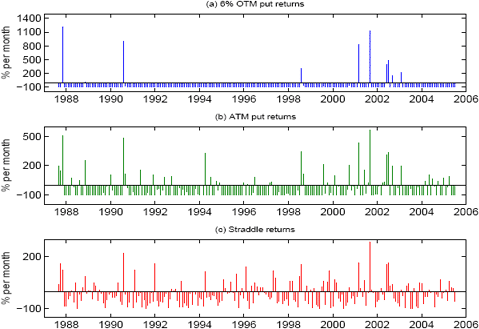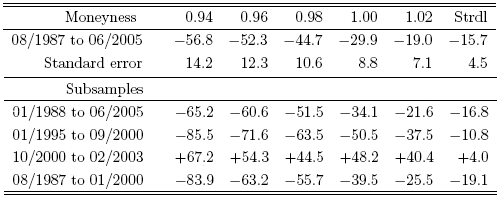Are equity investors on average irrationally afraid of market plunges, and therefore willing to overpay for index put options? In their October 2004 paper entitled “A Portfolio Perspective on Option Pricing Anomalies”, Joost Driessen and Pascal Maenhout investigate the benefits of index options positions to asset allocating investors. In the June 2007 version of their paper entitled “Understanding Index Option Returns”, Mark Broadie, Mikhail Chernov and Michael Johannes compare historical option returns to those generated by commonly used option pricing models. These studies find that:
“A Portfolio Perspective on Option Pricing Anomalies” measures index option returns using daily data for S&P 500 futures options from the Chicago Mercantile Exchange for the period January 1987 (including the 1987 crash) to June 2001. It focuses on two short-maturity strategies: (1) buying out-of-the-money (OTM) put options with 96% strike-to-spot ratio; and, (2) buying at-the-money (ATM) straddles. Both strategies trade at the turn of calendar months with closing residual maturities between eight weeks and two weeks (they do not hold to maturity).
The following table, extracted from the paper, summarizes monthly results for the underlying S&P 500 index futures (Equity), the OTM puts and the ATM straddles across the entire sample period. The mean monthly return is +1.3% for the S&P 500 index futures, -41% for the put options and -13% for the option straddles. Selling the put options and straddles would therefore have generated positive returns as rewards for assuming volatility and jump risks. While the volatilities (standard deviations) of the options positions are much higher than the volatility of the underlying index futures, the magnitudes of the Sharpe ratios are still greater for the options.
The authors conclude that:
- The option positions are economically and statistically significant and robust to inclusion of transaction costs and margin requirements.
- Short put option and straddle positions should be attractive to most asset allocating investors.
- Only loss-averse investors who hold highly distorted probability beliefs would buy such puts and straddles as hedges.
“Understanding Index Option Returns” examines monthly returns for short-maturity S&P 500 index futures options held to expiration for various strike prices over the period August 1987 to June 2005 (215 months). It addresses strike-to-spot ratios (moneyness) ranging from 0.94 to 1.02 in 2% increments, covering 85% of all one-month option transactions.
The following chart, taken from the paper, depicts the monthly returns over the entire sample period for 6% OTM put options, ATM put options and ATM straddles. It shows that most of the put option positions expire out of the money (-100% return), with intermittent equity market plunges generating occasional spikes in the return.
The following table, excerpted from the paper, summarizes average monthly returns and volatilities (standard errors) for the put option positions by moneyness and for the ATM straddles (Strdl). It shows that all positions generate on average large, statistically significant negative returns (for example, -30% per month for ATM put options). Selling these options therefore generates positive returns. However, the results for calendar-based subsamples show that the returns for put options are unstable over time, generating large positive returns during the 2000-2002 bear market.
In summary, a strategy of systematically selling index put options generates on average large abnormal returns but suffers occasional very large setbacks when the underlying index plunges.


